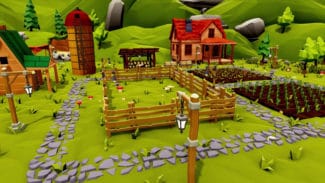In this feature we investigate how Paw Stamp Studio aims to recreate the simple farming pleasures of Stardew Valley in VR with their in-development game, Land of Amara.
Note: This game has been in development for several years and has undergone significant changes. The images and videos embedded in this article may not represent the game’s final version.
Land of Amara
Developing a game is a lot like farmwork. At least, that’s what Finn Pinkenburg discovered when he created Paw Stamp Studio and started his debut game, the VR farm simulator Land of Amara. It’s based on Pinkenburg’s love of games such as Harvest Moon and Stardew Valley, but like with starting a new game of Stardew Valley, Pinkenburg quickly realized the magnitude of the task ahead of him.
“I changed or completely reworked the project a lot of times and changed direction because I realized things weren’t working the way I wanted them to or the project wasn’t scalable,” Pinkenburg said. “That’s because I learned [game] development while doing it and made a lot of mistakes (and still am making quite a lot of mistakes). But it’s becoming better and better.”
Before founding Paw Stamp Studio Pinkenburg worked as a level designer for Quantum Frog Software in Hamburg, Germany. He became interested in programming after a while, which opened a new door for him.

“I realized I’d like to make something on my own because it’s totally a different thing when you do something for other people’s ideas instead of pursuing your own vision,” Pinkenburg said.
That vision was rooted in VR almost from the beginning. Pinkenburg first started tinkering with various test builds on PC, starting with an AI-controlled sheep. Shortly after that the seed for his idea sprouted and he purchased his first VR set, the Oculus Rift DK2, just to see how challenging VR development was.
The ease of creating a scene and, moreover, experiencing what Pinkenburg calls “real 3D” convinced him it was time to nurture his project in earnest.
“It was super easy,” Pinkenburg said of his first small VR development attempts. “You basically only had to exchange the camera rig to see everything in 3D. When I saw the sheep in front of me in 3D, I was blown away. It’s hard to describe. That’s when I decided to start Land of Amara and haven’t stopped since.”
Despite his newfound determination, Land of Amara was still very much a vulnerable seedling at that point.
“The project didn’t start with a vision of what it should become,” Pinkenburg said. “The only thing that was there was my experience playing games I always loved, like Stardew Valley and Harvest Moon. I had a goal to do something similar, but because I wasn’t aware I wanted to make my vision a fully playable game.”
He started a Land of Amara Patreon account in August 2018 to gauge interest in the project. The positive fan response — which Pinkenburg attributes to the absence of AAA developers in VR — encouraged him to continue, and in 2019, he brought a friend on board to help with design so he could handle programming. That’s when the difficulties started.
Like planning a new field, figuring out Land of Amara’s foundational features became Pinkenburg’s first challenge.
“I learned you can’t just go for things, since everything is a separate system on its own,” he said.
The first few builds released, including 2018’s playable demo, focused on testing prototypes and contained no actual gameplay systems. The latest playable version, released December 20, 2020, is the first with recognizable farming gameplay loops and a host of additional improvements, such as a tutorial system, new scenes, and a stamina system. It’s also laying the groundwork for relationships with NPCs through a new gift-giving mechanic. Additional systems leading to deeper relationships are still a ways off, though, since they aren’t as crucial for shaping the core experience.

Stardew Valley VR Ambitions
One thing Pinkenburg said he loves most about farm-sim games and wants to focus on is how, if designed well, they make simple grinding tasks feel worthwhile.
“I always felt Stardew Valley has a good balance between grinding and not giving you the feel it was grinding, when in the end, everything is grinding,” he said. “Relationships are a grinding system because of how you approach the townspeople every day. But it doesn’t feel like it because the end goal is a good way of making the grind feel rewarding. The same is true for other tasks like feeding the animals.”
Skill-based activities form another important element Pinkenburg wants to include, and he used Stardew Valley’s fishing as an example. While you can buy upgrades to make fishing easier, skill and learning the system ultimately determine success.
“You cannot lose the skill,” he said. “You gain it and always have it. So even if you start a new Stardew Valley game, you’re still good at fishing.”
Though he has a few physics-related ideas in mind, Pinkenburg said he’s not sure what kind of skill-based mechanics he wants for Land of Amara just yet.
However, adding gameplay elements with such evident similarities to existing games presents another challenge: balancing the heritage crops with the new hybrids. While Pinkenburg said he believes familiar mechanics feel fresh in VR just because players have to use them differently, he still isn’t satisfied with grafting other ideas onto Land of Amara.
“I don’t like copying things.I initially tried too hard to be different [with Land of Amara], and that caused my development progress to stop in some ways,” Pinkenburg said. “But I realized it’s way too hard to learn [game development] and re-invent the wheel at the same time. I think it’s pretty much impossible not to copy something from other games anyway.”

Pinkenburg used fishing as an example again. Land of Amara’s current fishing mode has players casting their line into the clouds beneath their island, but it’s mechanically similar to Stardew Valley’s fishing. Players use their hands to reel the line in and try to keep it in the sweet spot long enough to catch the fish.
It’s good enough — for now. Pinkenburg said he wants Land of Amara’s mechanics to stand out for more than just using VR physics and plans on overhauling them in future builds.
Speaking of VR mechanics, Pinkenburg ran into a bit of a quandary shortly after starting Land of Amara’s development, one that had far-reaching effects.
One thing Pinkenburg appreciates about VR is how it removes the extra interface between player and game.
“There was always something in between with other games, like a controller or keyboard, that converted actions,” he said. “VR doesn’t have that restriction, so the brain directly understands how things work because we know how to use our hands and how throwing works or how to chop a tree. That’s a huge difference, this instant transition into the game with your bare hands.”
That’s all well and good, but Pinkenburg soon realized it doesn’t make for a relaxing farming experience.
“I realized there are only a VR few games where you can just sit in your chair and chill while playing,” he said. “Imagine a game like Stardew Valley you sometimes play for hours in a row, and you have to move all the time. That would be way too exhausting. You should be able to play the game without doing anything physically, just sit in your chair and press one button again and again and get in this brain AFK mode.”
Pinkenburg took a four-month break from active updates earlier in 2020 to develop a solution to the problem, one that transformed both how he approaches Land of Amara and how players will experience it.
 Instead of using a first-person approach with physics-based controls built in, Land of Amara now lets players swap between first and third person at will. First person uses movement and motion controls, while in third person players see their farmer and move them around with controls, just like Stardew Valley or Harvest Moon.
Instead of using a first-person approach with physics-based controls built in, Land of Amara now lets players swap between first and third person at will. First person uses movement and motion controls, while in third person players see their farmer and move them around with controls, just like Stardew Valley or Harvest Moon.
He said he’s confident Land of Amara’s graphics and VR’s real 3D will keep players immersed, even when playing in third person, and perhaps even more so because they can appreciate the music and other effects even more.
Pinkenburg has a few ideas in mind for Land of Amara’s music that he thinks will likely raise some eyebrows. Stardew Valley uses a blend of retro and synth, while Harvest Moon gets by with charming, bucolic tunes for each season. He plans on Land of Amara’s farmers handling their daily routine accompanied by a specific kind of hip hop.
“I listen to a lot of lo-fi music when programming, and I discovered lo-fi is quite fitting,” he said. “So I put in some low-fi tracks which in some way is uncommon. The bass in lo-fi hip hop is not really something I know from most other farming games. I’m interested to see people’s reactions when they hear hip hop lo-fi in the latest version.”
Pinkenburg knows lo-fi hip hop won’t match everyone’s tastes, though, and added a radio system in the most recent version so players can import their own downloads to the game for a custom soundtrack.
To keep up with Land of Amara’s development, consider pledging to the Patreon.





